Parallel Methods and Higher Dimensional NLS Equations
Abstract
Alternating direction implicit (ADI) schemes are proposed for the solution of the two-dimensional coupled nonlinear Schrödinger equation. These schemes are of second- and fourth-order accuracy in space and second order in time. The resulting schemes in each ADI computation step correspond to a block tridiagonal system which can be solved by using one-dimensional block tridiagonal algorithm with a considerable saving in computational time. These schemes are very well suited for parallel implementation on a high performance system with many processors due to the nature of the computation that involves solving the same block tridiagonal systems with many right hand sides. Numerical experiments on one processor system are conducted to demonstrate the efficiency and accuracy of these schemes by comparing them with the analytic solutions. The results show that the proposed schemes give highly accurate results.
1. Introduction
In this paper, we derive two ADI schemes for solving the two-dimensional coupled nonlinear Schrödinger system, one is of second order in space and time directions, and the other one is of fourth order in space and second order in time. Both methods are producing a block nonlinear tridiagonal system; a fixed point method has been developed to solve this system. The proposed schemes are unconditionally stable using Fourier stability analysis.
The ADI method [8–15], which replaces the solution of multidimensional problems by sequences of one-dimensional cases, only needs to solve tridiagonal linear system or block tridiagonal systems, and the resulting schemes are unconditionally stable and received much attention in recent years.
The paper is organized as follows. In Section 2 we give two ADI schemes for solving the two-dimensional coupled nonlinear Schrödinger equation, and in Section 3, we present the von Neumann stability analysis for the proposed schemes. Numerical experiments for several problems are presented in Section 4. A parallel algorithm for the proposed ADI schemes is given in Section 5. Conclusions are given in Section 6.
2. Numerical Method
2.1. Second-Order ADI Method
Equation (16) is of second order in space.
2.2. Fourth-Order ADI Method
Now the systems in (35) and (36) are nonlinear. By the similar approach used in the previous scheme, we can derive a fixed point iterative formulas.
3. Stability Analysis
It can be easily shown that the modulus of the maximum eigenvalue of the amplification matrix G is less than one; hence, the scheme is unconditionally stable according to the von Neumann stability analysis.
4. Numerical Results
In this section, the efficiency and accuracy of the proposed schemes will be tested by comparing with the exact solutions. We will measure the accuracy of the proposed schemes using the L∞ norm. We compute the conserved quantity by using the trapezoidal rule.
4.1. Example 1
The boundary conditions are extracted from the exact solution (44).
Tables 1, 2, and 3 show the errors (ER) and the conserved quantities (I) for σ = 0, 1/6 and σ = 1/12, respectively. We have noticed that the scheme with σ = 1/12 produced highly accurate results, and this is due to the fourth order accuracy in space and second-order accuracy in time. The other two methods using σ = 0 and σ = 1/6 are of second-order accuracy in space and time. Figure 1 shows a single soliton at t = 0. Figure 2 shows the numerical solution at t = 1.
| Iter | T | ER | I |
|---|---|---|---|
| 0 | 0 | 0 | 24.99989 |
| 2 | 0.2 | 0.00435 | 25.00086 |
| 2 | 0.4 | 0.00886 | 25.00291 |
| 2 | 0.6 | 0.01365 | 25.00586 |
| 2 | 0.8 | 0.01893 | 25.00973 |
| 2 | 1.0 | 0.02439 | 25.01458 |
| Iter | T | ER | I |
|---|---|---|---|
| 0 | 0 | 0 | 24.99989 |
| 2 | 0.2 | 0.00436 | 24.99882 |
| 2 | 0.4 | 0.00859 | 24.99664 |
| 2 | 0.6 | 0.01277 | 24.99351 |
| 2 | 0.8 | 0.01750 | 24.98938 |
| 2 | 1.0 | 0.02206 | 24.98417 |
| Iter | T | ER | I |
|---|---|---|---|
| 0 | 0 | 0 | 24.99989 |
| 2 | 0.2 | 0.00011 | 24.99989 |
| 2 | 0.4 | 0.00018 | 24.99987 |
| 2 | 0.6 | 0.00025 | 24.99981 |
| 2 | 0.8 | 0.00030 | 24.99971 |
| 2 | 1.0 | 0.00036 | 24.99952 |
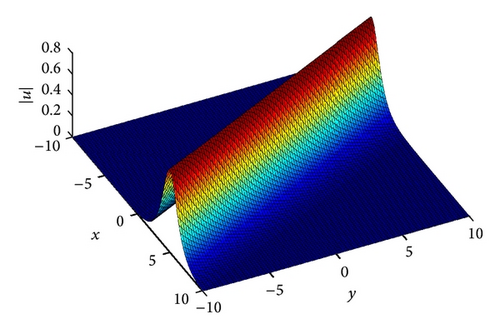
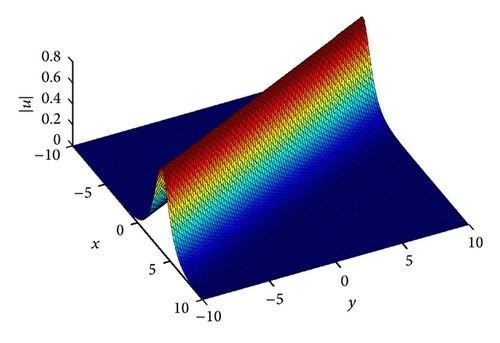
4.2. Example 2
In Figures 3 and 4, we display the numerical solution of |ψ|2 at t = 0 and t = 1, while in Figures 5 and 6 we display the numerical solution of |ϕ|2 at t = 0 and t = 1.
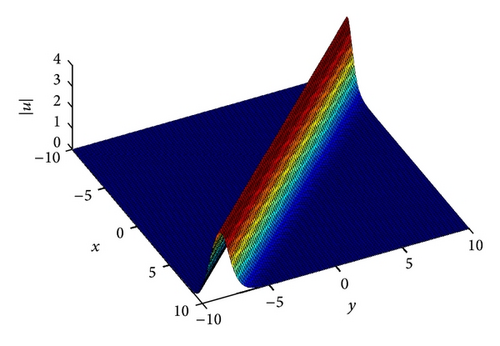
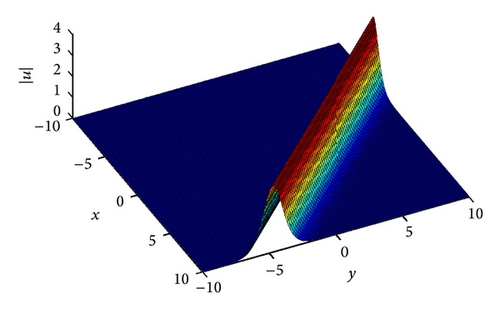
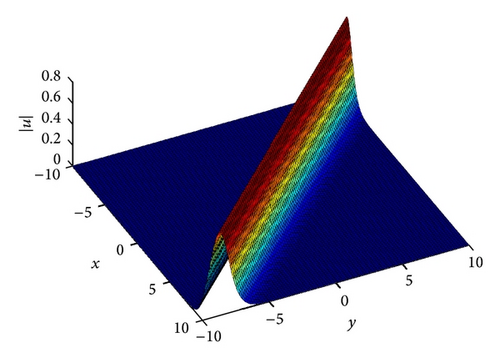
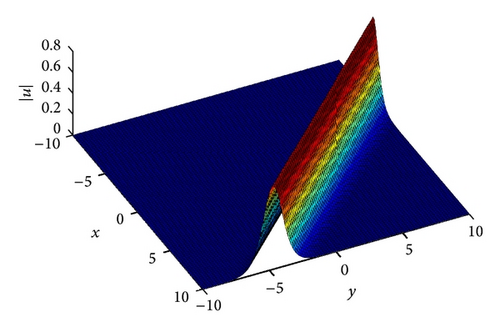
4.3. Example 3
The interaction scenario is given in Figures 7 and 8. In Figure 7 we show the two solitons with two different amplitudes at t = 0. In Figure 8 we display the interaction where the two solitons interact at t = 0.5, and, in Figure 9, we display the two solitons after the interaction at t = 1.5. In Table 4, we display the conserved quantities, and we see that the numerical method we proposed conserves the conserved quantities almost exactly. It is easy to see that the interaction regiem is an inelastic one. See [18].
| T | I1 | I2 |
|---|---|---|
| 0.0 | 1.57080 | 1.00531 |
| 0.5 | 1.57086 | 1.00533 |
| 1.0 | 1.57065 | 1.00522 |
| 1.5 | 1.57060 | 1.00520 |
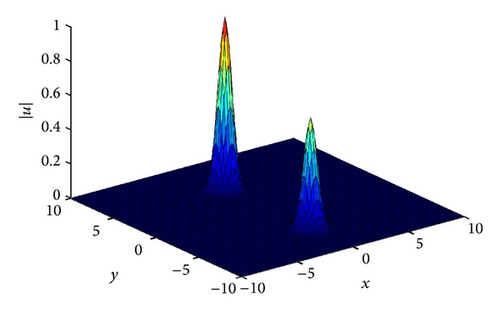
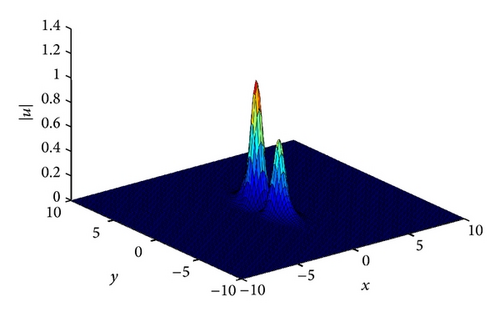
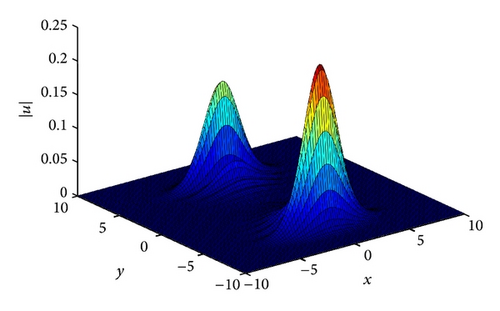
4.4. Example 4
Initial and boundary conditions are extracted from the exact solution. In this example we choose σ = 1/12, the fourth order ADI method. The numerical results are presented in Table 5. Figure 10 displays the solution at t = 0, and Figure 11 displays, the solution at t = 1.
| Iter | T | ER | I |
|---|---|---|---|
| 0 | 0.0 | 0.000000 | 39.478420 |
| 2 | 0.2 | 0.000003 | 39.478420 |
| 2 | 0.4 | 0.000005 | 39.478420 |
| 2 | 0.6 | 0.000007 | 39.478420 |
| 2 | 0.8 | 0.000009 | 39.478420 |
| 2 | 1.0 | 0.000008 | 39.478420 |

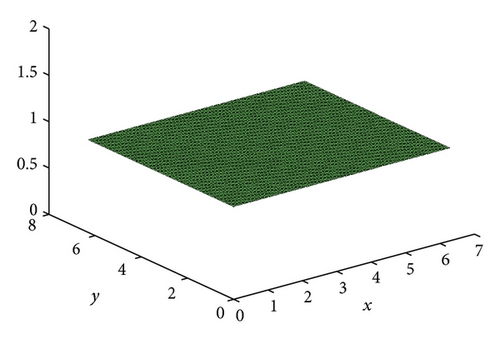
Table 4 displays the accuracy of the scheme and preserves the conserved quantities.
5. Parallel Algorithm for the Proposed ADI Schemes
It is to be noted that the implementation of the ADI schemes requires solving the same block-tridiagonal matrix with different right-hand sides. This can be done efficiently by using the fast parallel algorithm given in [19]. This algorithm [19] is a generalization of the parallel dichotomy algorithm for solving tridiagonal liner system of equations [20].
It has been shown that this dichotomy yields almost a linear speedup on a high performance system with many processors [19]. We expect the same speedup for our proposed methods. The parallel implementation of the proposed ADI method will be reported in our future work.
6. Concluding Remarks
In this present work, a generalized alternating direction implicit methods for solving two-dimensional coupled nonlinear Schrödinger equation have been established, the methods are unconditionally stable. The methods produced schemes of second and fourth order accuracy in space and second order in time according to the selected value of σ. The numerical results have shown that the proposed schemes successfully combine accuracy and efficiency for the two-dimensional coupled nonlinear Schrödinger system. The implementation of the ADI schemes requires solving the same block-tridiagonal matrix with different right-hand sides. This can be done by using the fast parallel algorithm given in [19]. This algorithm yields almost a linear speedup on a high performance system with many processors [19]. We expect the same speedup for our proposed methods. The proposed schemes can be easily extended to solve higher dimensional coupled nonlinear Schrödinger system.
Acknowledgments
This work was funded by the Deanship of Scientific Research (DSR), King Abdulaziz University, Jeddah, under Grant no. (130-074-D1433). The authors, therefore, acknowledge with thanks the DSR technical and financial support.




